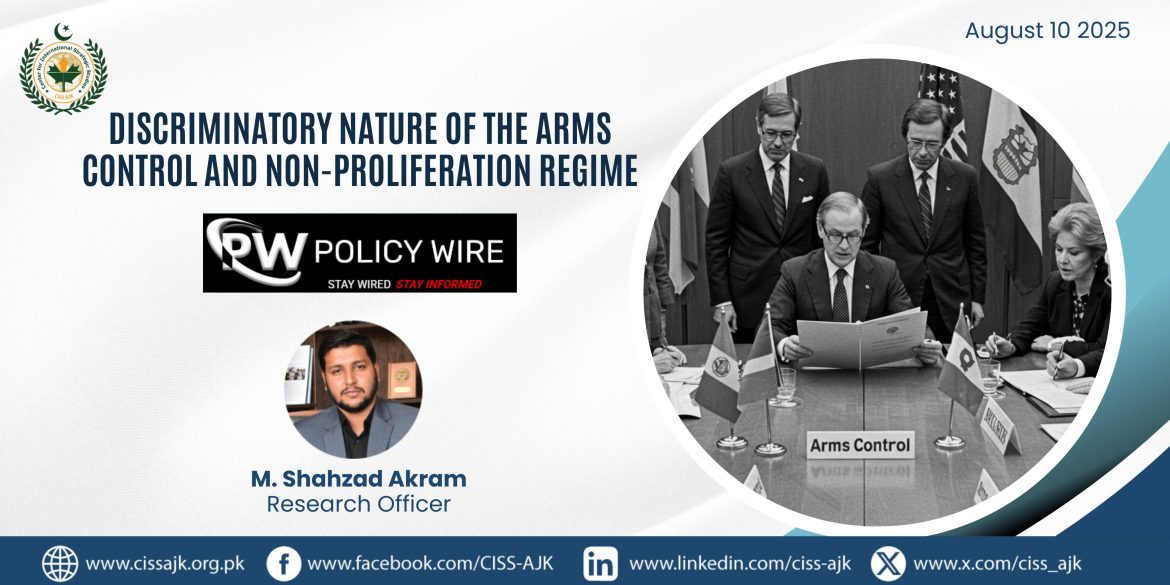In the contemporary global security environment, the arms control regime faces mounting pressures: the Russian invasion of Ukraine and its impact on strategic stability, ongoing nuclear modernization programs by several states, India’s expansion of missile and space launch capabilities, and the emergence of new military technologies such as hypersonic glide vehicles, drone swarms, and AI-enabled targeting. Additionally, the erosion of confidence in U.S. extended deterrence commitments, the June 2025 U.S.–Israeli strikes on Iranian nuclear facilities, and the selective application of non-proliferation rules have heightened concerns about proliferation and weakened confidence in arms control arrangements.
Selective Implementation of the NPT
The Nuclear Non-Proliferation Treaty (NPT), in force since 1970, remains the cornerstone of global nuclear governance. Critics argue it has been implemented selectively, largely serving the strategic interests of nuclear-weapon states (NWS). One long-standing dispute involves NATO’s nuclear-sharing arrangements, under which U.S. nuclear weapons are stationed in non-nuclear-weapon states (NNWS). Members of the Non-Aligned Movement (NAM) have argued this practice contravenes Articles I and II of the NPT; NATO and allied legal advisers maintain it does not breach the treaty’s text, citing arrangements that predate the NPT’s entry into force. The disagreement remains unresolved in international legal discourse.
Many arms control treaties emerged during the Cold War, when non-proliferation took precedence over disarmament. Although Article VI of the NPT commits all parties to pursue nuclear disarmament, progress has been slow, fueling perceptions that the treaty entrenches the technological monopoly of the “nuclear haves” over the “nuclear have-nots.”
The Indo–U.S. Nuclear Deal and NSG Waiver
The 2008 U.S.–India Civil Nuclear Agreement and the Nuclear Suppliers Group (NSG) waiver allowing nuclear trade with India — a non-NPT nuclear-armed state — remain among the most cited examples of perceived double standards. Opponents contend that the waiver undermined Articles I and II of the NPT by granting a special exception to a non-signatory while pressuring NPT parties to accept stricter controls. Supporters argue it brought India’s civilian facilities under IAEA safeguards and deepened its integration into non-proliferation norms. In South Asia, however, Pakistan responded by accelerating its nuclear program to maintain deterrence, contributing to an arms race dynamic.
Stalled Treaties and Neglected Domains
Two critical but incomplete pillars of the global regime are the Comprehensive Nuclear-Test-Ban Treaty (CTBT) — not yet in force due to pending ratifications — and the still-unnegotiated Fissile Material Cut-off Treaty (FMCT). Both are viewed as essential to halting qualitative and quantitative arms races. Additionally, the Prevention of an Arms Race in Outer Space (PAROS) remains unresolved, as military competition in space intensifies.
Middle East Nuclear-Free Zone: Persistent Deadlock
Since 1974, UN resolutions — notably A/RES/3263 (XXIX) — have called for a Middle East nuclear-weapon-free zone (NWFZ). Israel’s policy of nuclear ambiguity, combined with U.S. political protection, has been identified by many states as a central obstacle. By contrast, Iraq, Libya, and Iran have faced intensive scrutiny and sanctions over their nuclear activities. The asymmetry fuels perceptions of discriminatory enforcement.
The Iranian Case
The Joint Comprehensive Plan of Action (JCPOA), implemented in 2016 after IAEA verification of Iran’s compliance, was widely hailed as a success. The U.S. withdrawal in 2018 and Iran’s subsequent partial non-compliance weakened the agreement. In June 2025, Israeli strikes — reportedly with U.S. involvement — targeted Iranian nuclear facilities under IAEA safeguards. The IAEA expressed deep concern, noting that such attacks raise serious nuclear safety and legal issues, and that facilities under safeguards are meant for peaceful purposes.
At the 2010 NPT Review Conference, states agreed that attacks or threats of attack on safeguarded nuclear facilities jeopardize nuclear safety, carry dangerous political and environmental consequences, and raise questions under international law regarding the use of force.
Such incidents reinforce the perception that NPT membership does not guarantee protection for civilian nuclear infrastructure, potentially eroding incentives for states to remain within the treaty framework.
Structural Inequities and “Nuclear Apartheid” Debate
Brigadier (R) Zahir Kazmi and others have described the global non-proliferation architecture as a form of “neo-nuclear apartheid,” extending beyond the NPT to export control cartels such as the NSG. Historical warnings, such as Ambassador V.C. Trivedi’s 1967 caution against “atomic apartheid,” resonate today: India, despite rejecting the NPT and conducting nuclear tests, received an NSG waiver; Pakistan, despite cooperating with the IAEA and supporting UN resolutions, remains excluded from the NSG — limiting its ability to meet civilian energy needs. Israel, an undeclared nuclear-armed state outside the NPT, faces minimal international scrutiny, while Iran and North Korea endure significant sanctions. Such disparities fuel mistrust, encourage hedging strategies, and risk undermining the legitimacy of the entire regime.
The NPT and related regimes remain indispensable for global security, but their perceived selectivity and uneven enforcement have weakened trust. If left unaddressed, these inequities will continue to drive proliferation pressures, heighten regional insecurities, and complicate efforts to strengthen arms control. A more balanced approach — including equitable treatment of states in export-control forums, genuine progress on disarmament commitments, and consistent application of safeguards obligations — would help restore the NPT’s legitimacy and fulfill its original promise of balanced rights and responsibilities.
About the Author
Muhammad Shahzad Akram is a Research Officer at the Centre for International Strategic Studies, AJK. He holds an MPhil in International Relations from Quaid-i-Azam University, Islamabad, and is an alumnus of the Near East South Asia (NESA) Centre for Strategic Studies, National Defence University (NDU), Washington, DC. His expertise includes cyber warfare and strategy, arms control, and disarmament.



